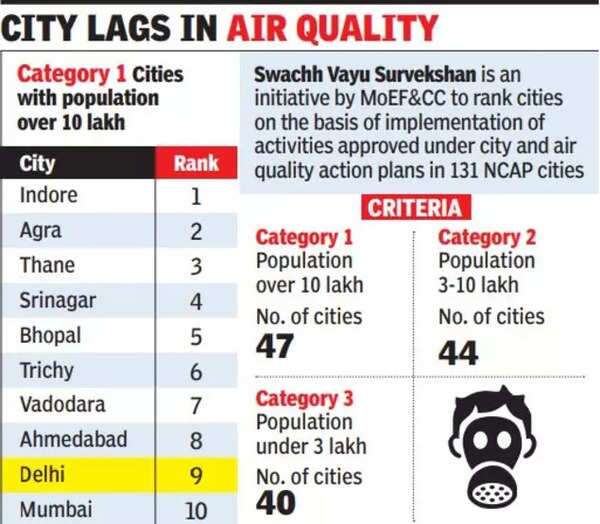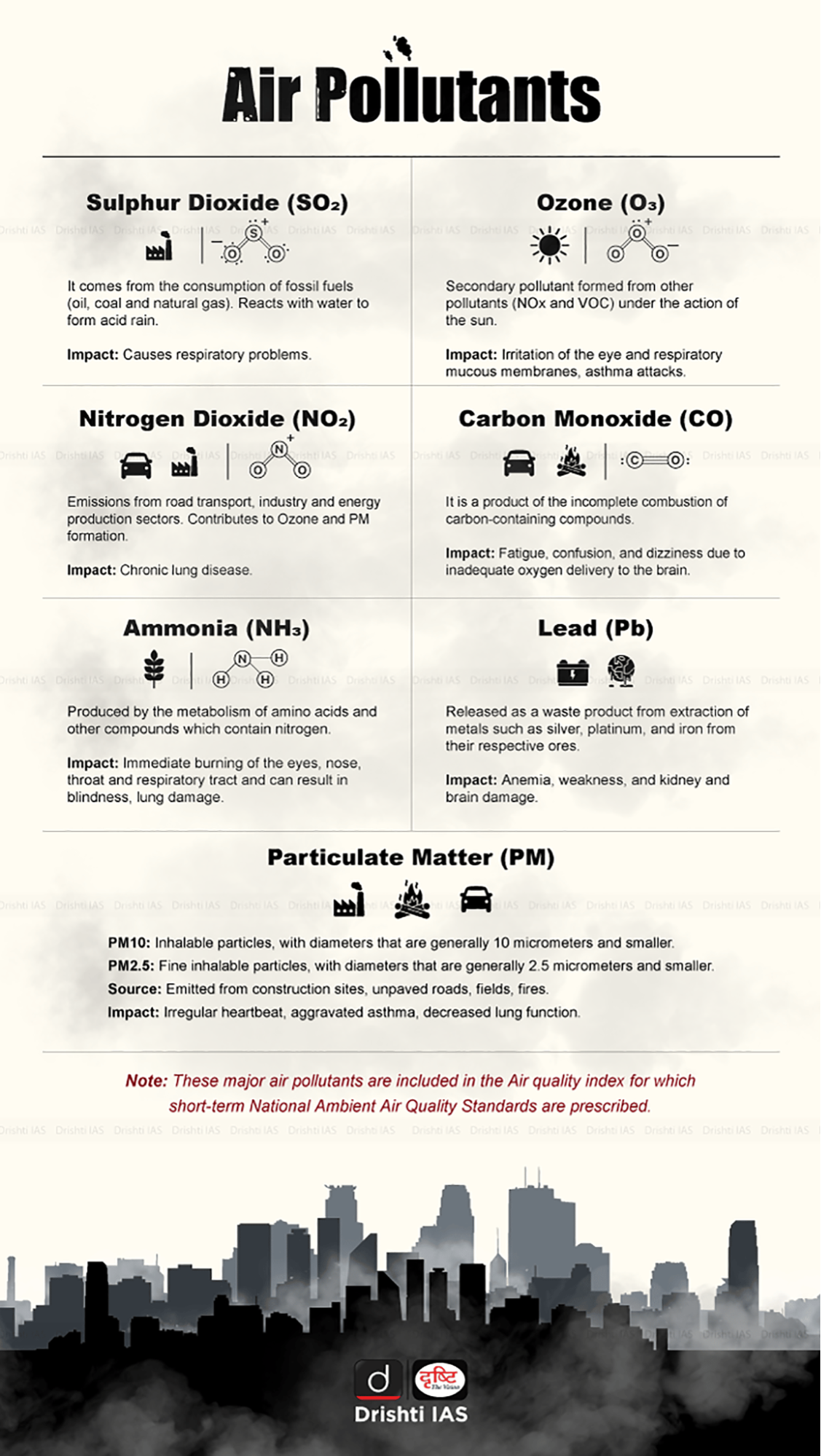Governance
Swachh Vayu Survekshan 2023 and NCAP
- 08 Sep 2023
- 7 min read
For Prelims: Swachh Vayu Survekshan 2023, Clean Air Survey, Central Pollution Control Board (CPCB), International Day of Clean Air for Blue Skies, National Clean Air Programme (NCAP), Initiatives to Ensure Cleaner Air, PM 2.5, PM 10, NAAQS, Air Pollution
For Mains: The problem of Air Pollution and Government Initiatives to tackle it
Why in News?
Recently, the awards for Swachh Vayu Survekshan (Clean Air Survey) 2023 were announced. The survey was conducted by the Central Pollution Control Board (CPCB).
Note:
- Every year, the International Day of Clean Air for Blue Skies is celebrated on 7 September to raise awareness and facilitate actions to improve air quality.
- It was declared so by the United Nations General Assembly (UNGA) in 2019.
- Theme for 4th International Day of Clean Air for Blue Skies (Swachh Vayu Diwas 2023) - “Together for Clean Air.”
What are the Key Findings about the SVS 2023?
- About:
- Swachh Vayu Survekshan (SVS) is a new initiative by the Ministry of Environment, Forest and Climate Change (MoEFCC) to rank cities on the basis of air quality and implementation of activities approved under the city action plan (NCAP) in 131 non-attainment cities.
- Cities are declared non- attainment if over a 5-year period they consistently do not meet the NAAQS for PM10 or NO2.
- The categorisation of cities has been based on the 2011 population census.
- Swachh Vayu Survekshan (SVS) is a new initiative by the Ministry of Environment, Forest and Climate Change (MoEFCC) to rank cities on the basis of air quality and implementation of activities approved under the city action plan (NCAP) in 131 non-attainment cities.
- Criteria: The cities were assessed on eight major points:
- Control of biomass
- Municipal solid waste burning
- Road dust
- Dust from construction and demolition waste
- Vehicular emissions
- Industrial emissions
- Public awareness
- improvement in PM10 concentration
- Performance:
- Top 3 cities under 1st category (million plus population): Indore followed by Agra and Thane.
- Worst Performers: Madurai (46), Howrah (45) and Jamshedpur (44)
- Bhopal ranked 5th and Delhi ranked 9th
- Worst Performers: Madurai (46), Howrah (45) and Jamshedpur (44)
- Top 3 cities under 2nd category (3-10 lakhs population): Amravati followed by Moradabad and Guntur.
- Worst Performers: Jammu (38), Guwahati (37) and Jalandhar (36)
- Top 3 cities under 3rd category (<3 lakhs population): Parwanoo followed by Kala Amb and Angul.
- Worst Performer: Kohima (39)
- Top 3 cities under 1st category (million plus population): Indore followed by Agra and Thane.
- Comparison:
- In SVS 2022, the first three spots (million-plus category) were secured by cities in Uttar Pradesh — Lucknow (1), Prayagraj (2) and Varanasi (3).
- All three cities have been ranked lower this year.
- In SVS 2022, the first three spots (million-plus category) were secured by cities in Uttar Pradesh — Lucknow (1), Prayagraj (2) and Varanasi (3).
Note:
- In 2020, the Prime Minister of India announced the intent and plan to improve the air quality in more than 100 cities through a holistic approach.
- In the context, the MoEFCC has been implementing a National Clean Air Programme (NCAP) as a national-level strategy outlining the actions for reducing the levels of air pollution at city and regional scales in India since 2019.
What is the NCAP?
- About: The National Clean Air Programme (NCAP) aims to systematically address air pollution by engaging all stakeholders and ensuring necessary action.
- 131 cities have been identified for the implementation of the city specific action plans under NCAP.
- Target: It is the first-ever effort in the country to frame a national framework for air quality management with a time-bound reduction target.
- It seeks to cut the concentration of coarse (PM10) and fine particles (PM2.5) by at least 20% in the next five years (base year for comparison - 2017).
- Monitoring: The “PRANA” portal has also been launched by MoEFCC for:
- Monitoring implementation of NCAP.
- Monitoring the action plans and implementation status of cities.
- Sharing best practices adopted by cities for others to emulate.
Other Initiatives to Ensure Cleaner Air:
UPSC Civil Services Examination, Previous Year Questions
Prelims:
Q. In the context of WHO Air Quality Guidelines, consider the following statements: (2020)
- The 24-hour mean of PM2.5 should not exceed 15 µg/m³ and annual mean of PM2.5 should not exceed 5 µg/m³.
- In a year, the highest levels of ozone pollution occur during the periods of inclement weather.
- PM10 can penetrate the lung barrier and enter the bloodstream.
- Excessive ozone in the air can trigger asthma.
Which of the statements given above are correct?
(a) 1, 3 and 4
(b) 1 and 4 only
(c) 2, 3 and 4
(d) 1 and 2 only
Ans: (b)
Q. Consider the following statements: (2017)
- Climate and Clean Air Coalition (CCAC) to Reduce Short Lived Climate Pollutants is a unique initiative of G20 group of countries.
- The CCAC focuses on methane, black carbon and hydrofluorocarbons.
Which of the statements given above is/are correct?
(a) 1 only
(b) 2 only
(c) Both 1 and 2
(d) Neither 1 nor 2
Ans: (b)
Mains:
Q. Mumbai, Delhi and Kolkata are the three megacities of the country but the air pollution is a much more serious problem in Delhi as compared to the other two. Why is this so? (2015)






